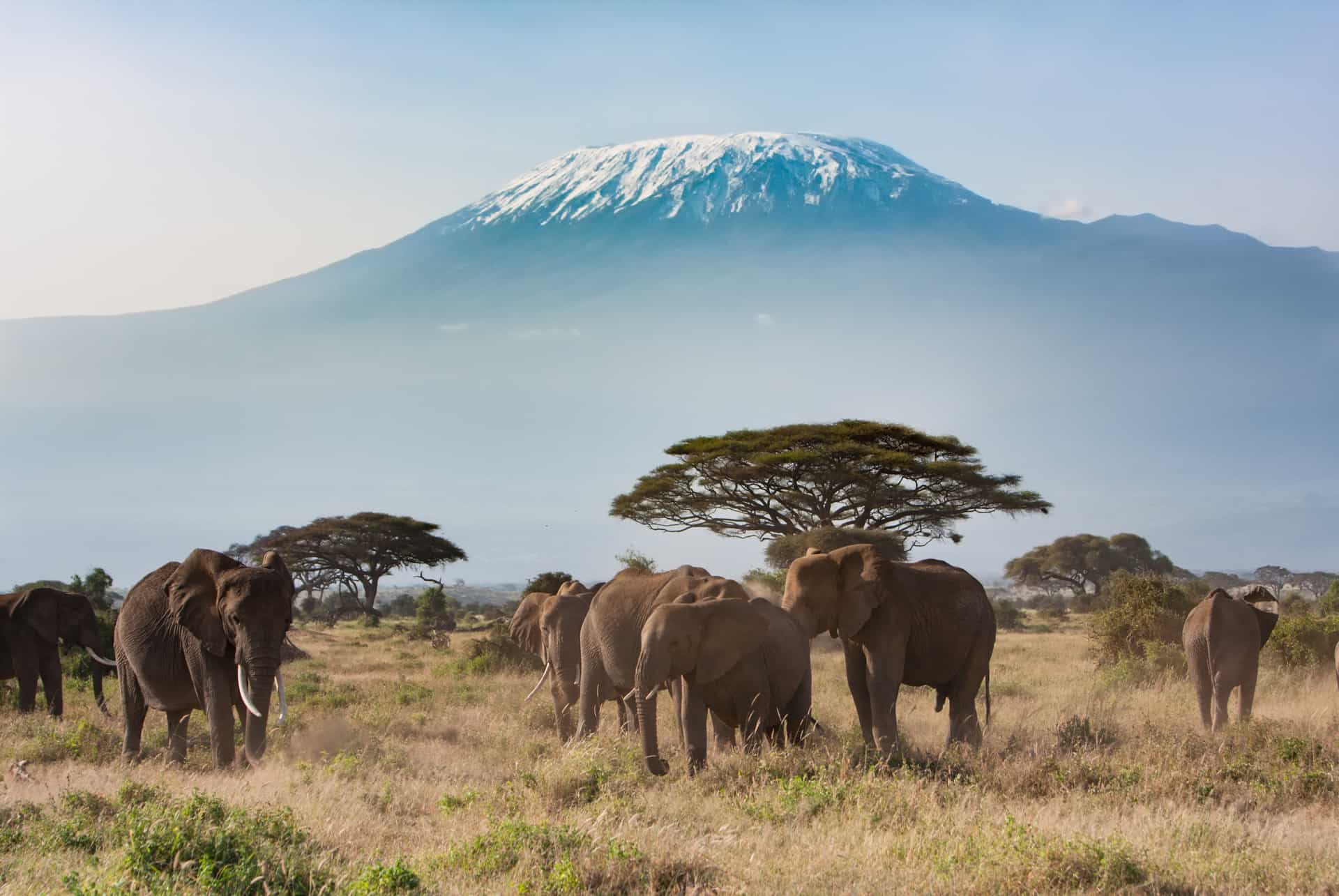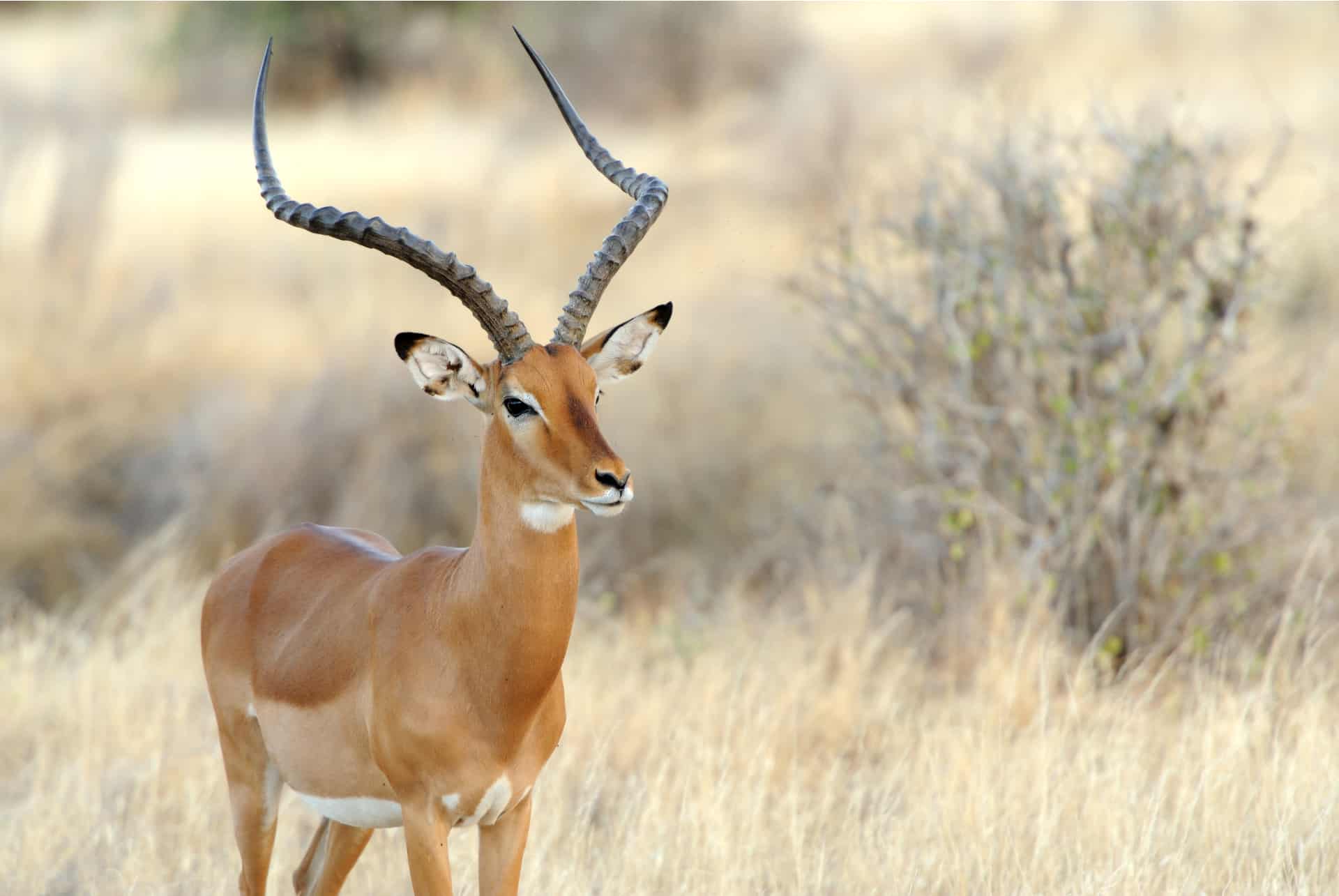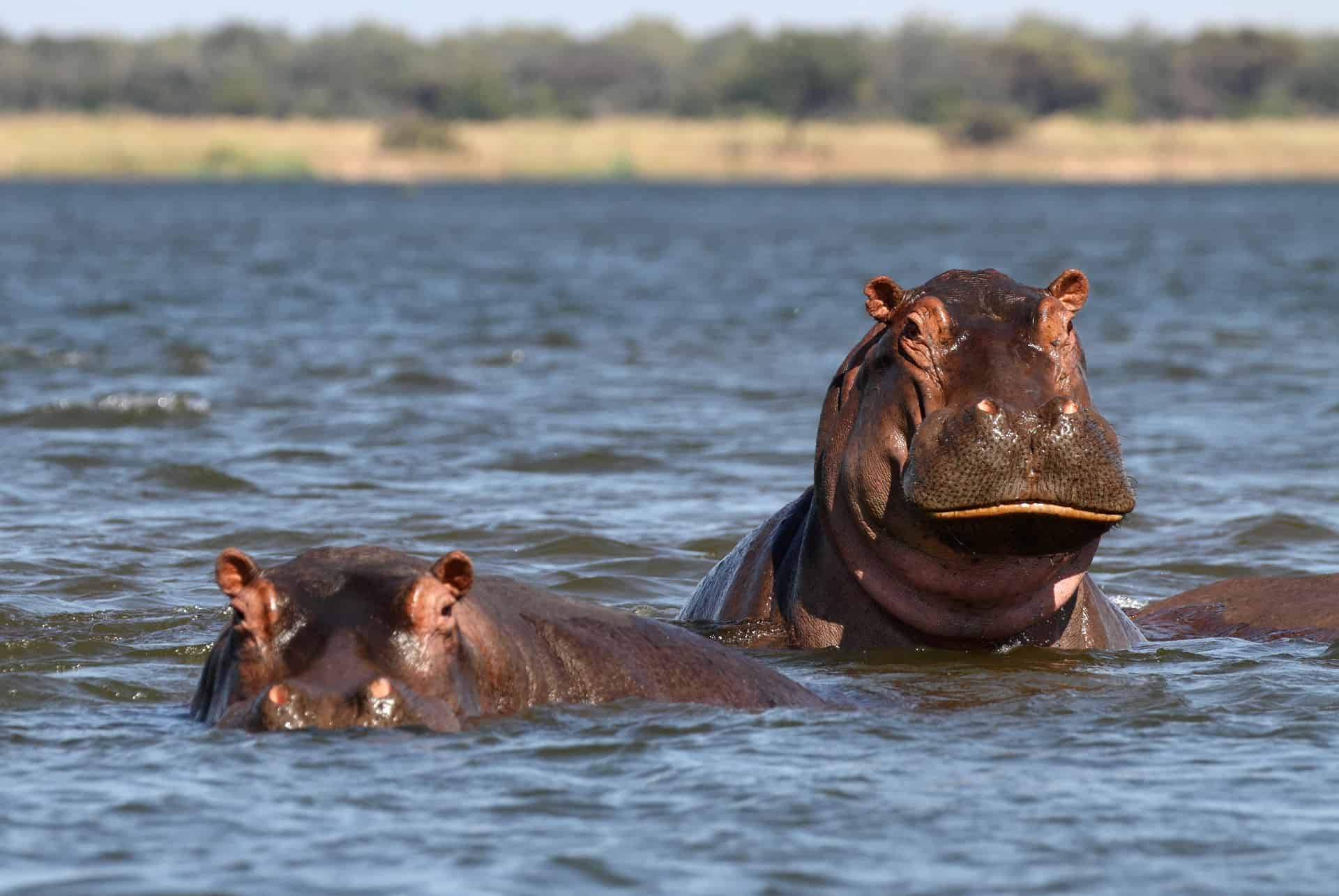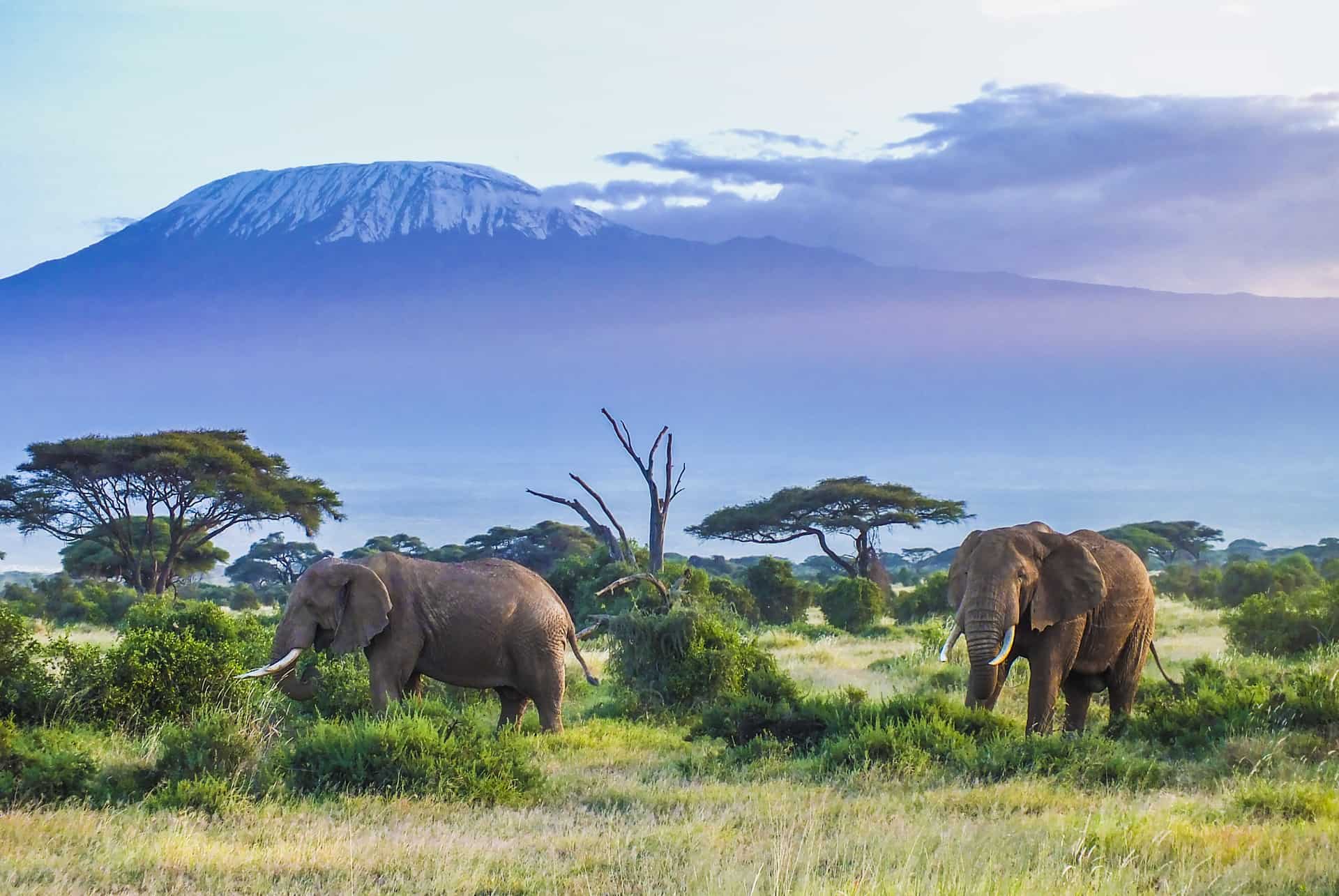If you go on a safari in Kenya, you'll get to discover many parks and national reserves. In addition to the Masái Mara National Reserve, there is another must-see destination: the Amboseli National Park. This park, much smaller than others in Africa, stands out for its great accessibility, its high concentration of wildlife and its incredible views of Africa's highest peak.
Amboseli: one of Africa's most iconic parks

Amboseli National Park lies around 155 miles south-east of Nairobi (250 km). It is the country's second most visited park, behind the Masái Mara National Reserve, which is further west. It covers an area of 151 square miles (about 392 km²) and was a game reserve before becoming a national park in 1975 and being classified as a biosphere reserve by UNESCO in 1980. It is managed by the Kenya Wildlife Service, as are most of the country's parks and reserves (Lake Nakuru, Tsavo, Nairobi National Park, Hells Gate, Shimba Hills, etc.).
The name "Amboseli" is a Maasai term meaning "salty dust", due to the presence of a large, virtually dry lake in the centre of the plain. But though part of the park is indeed dusty and arid, the eternal snows found at the summit of Kilimanjaro bubble up in certain parts of the park, after having melted and flowed through porous volcanic rocks. This water ends up forming wetlands that are particularly popular with animals, and birds in particular.
The park's scenery is therefore highly contrasting, with large arid desert plains, swamps and small oases of greenery.
The park is so renowned for the beauty of its landscapes and its impressive backdrop, with the savannah stretching as far as the eye can see and Kilimanjaro as a backdrop.
What to see and do in Amboseli National Park
See elephants in Amboseli
If there is one emblematic picture of Amboseli Park, it is that of a herd of elephants with Kilimanjaro in the background. And indeed, Amboseli National Park is undoubtedly one of the best places in the whole of Africa to see large numbers of elephants – and the best in East Africa.
It's also the perfect place to get really close to elephants. More than 1,500 pachyderms are gathered here, and although there are even more in other Kenyan parks, this is where their concentration is greatest. As every effort is made to stop poaching in this region, the population is increasing and many of the elephants are sporting magnificent tusks.
On an Amboseli safari, you'll have no trouble spotting herds of elephants congregating near waterholes, and you'll no doubt be able to snap that iconic photo of a majestic pachyderm posing in front of Africa's highest peak.
What other animals can be seen in Amboseli Park?


Although this park is far from being the largest in the country (Tsavo National Park is almost 50 times bigger, covering an area of over 7,700 square miles – 20,000 km²), it is nevertheless home to a dense and highly diverse fauna. During the dry season, this park even becomes one of the best places in Africa to observe animals of Kenya and large African mammals.
As well as elephants, one can also see many of the animals that are emblematic of African safaris:
- Giraffes
- White rhino
- Zebra
- Wildebeest
- Buffalo
- Antelopes
- Hippos
- Warthogs
- More than 420 species of birds, many of which congregate around the wetlands (herons, African sacred ibises, black crowned cranes, kingfishers, marabouts, flamingos, etc.).
- And a few carnivores (cheetahs, jackals, lions and spotted hyenas).
In very rare cases, it is even possible to observe Africa’s Big Five game in this park – the African lion, African leopard, black rhinoceros, African bush elephant, and African buffalo. However, leopards are very discreet and black rhinos can only be seen on their travels between Kenya and Tanzania.
Go on a guided safari or a self-drive safari in Amboseli
Amboseli is one of the national parks that can be visited freely by driving yourself. You can choose to be accompanied by a guide and benefit from all his knowledge, or go off on your own for more freedom.
During the dry season, the tracks are very easy to negotiate, and there are plenty of signs, making Amboseli an ideal national park for a first self-drive safari experience. However, you will still need to do a bit of research beforehand, bring a map of the park and, of course, carefully observe the regulations and safety instructions.
How do I get to Amboseli National Park?

Such is not always the case for Africa's nature reserves and national parks, but Amboseli has the advantage of being a particularly accessible park. By car, it's around 4 hours from Nairobi and 7h30 from Mombasa, and the road leading there is very passable.
The park can also be reached by plane, with domestic flights departing from Wilson airport, Nairobi's second civilian airport. These flights take only 30 minutes to 1 hour and tickets generally cost around $220.
You can enter Amboseli Park from 4 different points:
- Iremito Gate to the northeast,
- Kimana Gate to the southeast,
- Namanga Gate to the north-west;
- Kitirua Gate to the south, though this one is accessible only during the dry season.
When to go on safari in Amboseli Park?
Amboseli National Park can be visited all year round, but like Kenya's other parks, it is most easily accessible during the dry seasons. During periods when it rains more often, it's harder to drive on the tracks, the rain and humidity make travel and observation less pleasant, and the denser vegetation offers plenty of cover for animals that don't want to show themselves. The rainy seasons, starting in April and November, are therefore best avoided.
The ideal time for a safari in Amboseli is from June to October, and conditions are also very good during the other dry season, between mid-December and mid-March.
Where to sleep when visiting Amboseli Park?

You have two options on an Amboseli safari: sleeping inside the park or sleeping outside. To get the most out of this experience, a 2-day safari is a minimum — and if your budget allows, you will never regret spending the night inside the park.
Inside the park or nearby, you'll find different types of accommodation:
- Campsites where you can sleep in your own tent with fairly rustic comforts and simple access to running (and drinking) water, with sanitary facilities and sometimes barbecue facilities. This is the cheapest way to sleep in the park, and offers an unforgettable night in the wilderness.
- Safari camps are much more luxurious and well-equipped. They are made up of spacious tents, often with real floors and a host of facilities (showers, full kitchens, restaurants, swimming pools, etc.). Prices can vary widely depending on location and quality of service.
- Lodges, which are more like hotels or resorts, with accommodation in bungalows or real dwellings. These are very touristy establishments, often offering full-board accommodation. The most popular lodges are located in the heart of Amboseli Park, or very close to the entrances.
Prices of an Amboseli National Park visit
If your safari is organized by a local agency, your ticket will be provided and all extras will already be included in the price of your package. If you are organizing your own safari to visit Amboseli Park, you will need a ticket valid for one person for 24 hours. The price is the same, regardless of which park entrance you buy it at:
- $60 for an adult (18 and over),
- $35 for a child (aged 3 to 17).
In addition to this entrance fee, you'll need to pay a vehicle fee:
- 300 KSH (Kenyan shillings) for a vehicle with 5 seats or less (approx. $2.15),
- 1030 KHS for a vehicle with 6 to 12 seats (approx. $7.35),
- 2585 KHS for a vehicle with 13 to 24 seats (approx. $18.40).
On-site activities are also available for a fee:
- Night safari for 2155 KSH (approx. $15.35),
- Walking safari for KSH 1,500 (approx. $10.70),
- Bike rental for 215 KSH (less than $2),
- Horseback riding for 1030 KSH (approx. $7.35).
Rules to follow on safari in Amboseli

As in all Kenya's national parks, rules are in place to protect the flora and fauna, but also to ensure the safety of visitors:
Always keep your distance from the animals. A minimum distance of 82 feet is recommended (25 meters), and it is forbidden to leave the vehicle outside pedestrian zones, such as Noomotio Observation Hill.
Vehicle speeds must not exceed 40 mph (65 km/h).
Noise must be kept to a minimum.
It is forbidden to drive in the wilderness.
Do not feed the animals.
It is strictly forbidden to leave garbage in the wild.
0 Comments